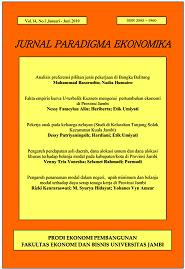Pekerja anak pada keluarga nelayan (Studi di Kelurahan Tanjung Solok Kecamatan Kuala Jambi)
DOI:
https://doi.org/10.22437/paradigma.v14i1.6794Abstract
This study aims to analyze the socio-economic characteristics and the factors that influence the working hours of child labor in fisherman families. Data is sourced from survey of child workers in fisherman families in Tanjung Solok Sub-District, Kuala Jambi District. Data were analyzed descriptively as well as multiple regression analysis. The results of the study found that the average age of child labor was 12.17 years, and most elementary school education was equivalent. The main reason children work is to increase family income and want to have their own income. The average child worker has worked for 2.35 years. There are various types of work carried out by children, with average working hours of child workers 18.25 hours per week and an average income of 217,564 per week. Simultaneously or partially, the working hours of children are influenced by the education of the family head, income of the family head, income of child labor, age of child labor, education of child labor, number of dependents of the family head, and number of family members working.
Downloads
Downloads
Published
Versions
- 2019-05-12 (1)
- 2019-05-12 (1)









